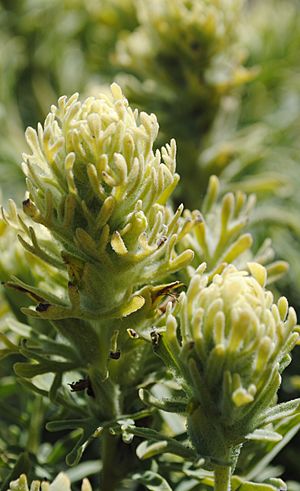San Clemente Island Indian paintbrush facts for kids
Quick facts for kids San Clemente Island Indian paintbrush |
|
|---|---|
 |
|
| Conservation status | |
| Scientific classification | |
| Genus: |
Castilleja
|
| Species: |
grisea
|
Castilleja grisea is a special and rare wild flower. It's often called the San Clemente Island Indian paintbrush. This plant only grows on San Clemente Island. This island is part of the Channel Islands off the coast of California. The US Navy owns San Clemente Island. They are working hard to help this unique plant recover.
What Does the San Clemente Island Indian Paintbrush Look Like?
This plant is a type of herb. It lives for many years, which means it's a perennial. It is covered in many long, gray hairs. Its stem branches out a lot and grows about 40 to 60 centimeters (16 to 24 inches) tall. The leaves are long and thin, each a few centimeters long.
The plant has a special flower part called an inflorescence. This part is made of layers of leaf-like structures called bracts. These bracts are one to two centimeters long. They are gray-green at the bottom and turn greenish-yellow at the tips. Between these bracts, you can see dull yellow flowers. These flowers look like small pouches. After the flowers, the plant grows a fruit. This fruit is a capsule about one centimeter long. Inside, it holds tiny seeds with a net-like pattern on their surface.
Where Does the San Clemente Island Indian Paintbrush Live?
This plant used to be quite common on San Clemente Island. However, its home was badly damaged over time. This damage was mostly caused by feral goats. These goats were brought to the island and roamed freely. Other animals like sheep, cattle, and some feral pigs were also present.
These animals sometimes ate the plants. But their main damage came from walking all over the land. This caused the soil to become very hard and packed down. It also led to the loss of topsoil and erosion. This means the valuable top layer of soil was washed or blown away.
New plant species were also brought to the island. These are called introduced species. Examples include ripgut brome, wild oat, and red brome. These new plants also harmed the natural home of the Indian paintbrush.
Because San Clemente Island has very steep hills, it's hard to know exactly how many Castilleja grisea plants there are. However, recent studies have found new groups of these plants. In 2007, experts estimated there were more than 10,000 plants.
Protecting the San Clemente Island Indian Paintbrush
This plant has been listed as an endangered species since 1977. It was one of the first species to get this special protection. The number of plants had dropped a lot because of the wild goats.
Since the goats were removed from the island, the plant's population has grown a lot. It has increased more than ten times! The US Navy has done a great job managing programs to help the plant recover. Because of this success, experts have suggested that the plant's status could be changed. It might be moved from "endangered" to a less critical category.
However, some dangers still remain for the plant. These include ongoing erosion, the spread of invasive grasses, and wildfires. Wildfires can sometimes start from military exercises on the island.
Even though it's a rare plant that only lives on one island, it has good genetic variability. This means it has a healthy mix of different genes. This, along with its steady recovery, gives a hopeful outlook for the future of the San Clemente Island Indian paintbrush.


